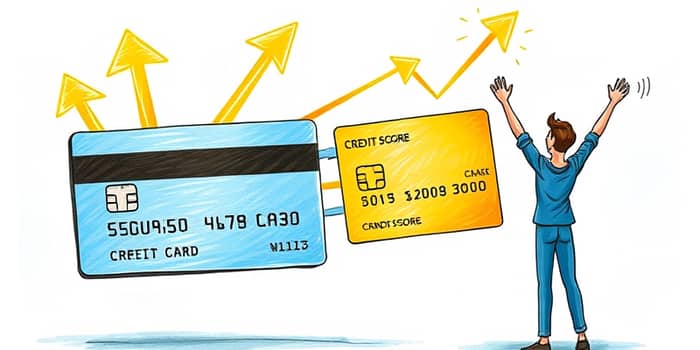Secured credit cards serve as a crucial stepping stone for anyone looking to establish or rebuild their credit. While they require a refundable security deposit, their ultimate purpose is to transition you to a true, unsecured credit card—unlocking better terms, higher limits, and more rewards.
Understanding Secured vs. Unsecured Cards
Secured credit cards require a security deposit, typically ranging from $49 to $300 or more. This deposit becomes your credit limit and acts as collateral if you fail to make payments.
Unsecured credit cards, by contrast, don’t require collateral. They often offer higher limits, robust rewards programs, and better interest rates. The goal is to use a secured card to build a sterling credit history so that issuers feel confident upgrading you to an unsecured product.
How Graduation Works
The process of converting a secured card into an unsecured one is known as graduation, upgrading, or unsecuring. Once you meet an issuer’s criteria—which varies by bank—the deposit is refunded, and your account is either converted or replaced with an unsecured card.
Key evaluation factors include payment history, credit utilization, and overall credit score improvement. Most issuers review accounts periodically, often between 6 and 18 months after account opening.
General Criteria for Graduation
While specific policies differ, most card issuers look for these factors:
- Consistent on-time payments and account handling
- Credit score of at least 620 to 650
- Maintaining utilization at or below 30%
- Positive overall credit behavior and reporting
Top Cards That Graduate to Unsecured
Below is a comparison of leading secured cards known for their upgrade pathways:
Benefits of Graduating
Upgrading from secured to unsecured carries several advantages:
- Refund of your initial security deposit
- Access to higher credit limits and better rewards
- No longer needing collateral to borrow
- Often lower interest rates and more perks
Timeline Expectations and Influencing Factors
Graduation timelines vary based on issuer policies and your credit behavior. Generally, expect:
• A minimum of 6 months of responsible use
• Up to 18 months for detailed reviews
Factors that speed or slow this timeline include your starting credit score, payment consistency, utilization ratio, and any adverse items on your report.
How to Accelerate Your Graduation
If you want to qualify faster, focus on these steps:
- Monitor credit reports regularly for errors
- Keep monthly utilization under 30%
- Pay full balances or at least above the minimum due
- Avoid opening too many accounts or inquiries
What to Do If You Don’t Graduate
If your card doesn’t upgrade as hoped, you still have options:
1. Apply for a different unsecured card once your score improves.
2. If approved, close the secured account and receive your deposit back, but consider timing to minimize score disruption.
3. Move your refunded deposit to a savings or emergency fund, preserving your financial cushion.
Pros and Cons of Secured Cards That Graduate
Understanding the trade-offs helps set realistic expectations:
- Pros:
- Opportunity to build or rebuild credit
- Refundable deposit protection
- Automatic path to better cards
- Some offer cash-back or rewards
- Cons:
- Initially low credit limits
- Limited rewards vs. unsecured cards
- Not all issuers guarantee graduation
Recommended Next Steps After Graduation
Once your secured card becomes unsecured, consider these follow-up actions:
• Maintain low balances to continue improving your credit score.
• Explore starter unsecured cards, such as the Fifth Third 1.67% Cash Back Card, which offers unlimited 1.67% cash back with no annual fee.
• Continue practicing responsible credit management practices to qualify for premium cards down the line.
Conclusion
Secured credit cards provide a clear, structured route to building credit history. By focusing on timely payments, keeping utilization low, and monitoring your credit profile, you can graduate to an unsecured card within 6 to 18 months. This journey not only unlocks better terms and rewards but also teaches invaluable financial discipline. Start with the right card, follow best practices, and watch your credit opportunities unfold.
References
- https://www.bankrate.com/credit-cards/building-credit/best-secured-cards-graduate-unsecured/
- https://www.discover.com/credit-cards/card-smarts/doing-what-it-takes-to-graduate-from-your-secured-card/
- https://www.capitalone.com/learn-grow/money-management/unsecuring-capital-one-secured-card-upgrade/
- https://bettermoneyhabits.bankofamerica.com/en/credit/transitioning-to-unsecured-credit-card
- https://www.bankrate.com/credit-cards/building-credit/secured-card-to-unsecured-card/
- https://www.mtb.com/library/article/5-benefits-of-a-secured-credit-card
- https://www.creditonebank.com/articles/how-long-does-it-take-for-a-secured-card-to-become-unsecured
- https://www.53.com/content/fifth-third/en/financial-insights/personal/financial-education/is-a-secured-or-unsecured-card-best-for-you.html










